One of the best things about fishing is that it’s an activity almost anyone can enjoy - you don’t need a huge boat to enjoy a day on the water with friends. Really, you don’t need a boat at all - you can fish off the dock!
That means there are plenty of people with small boats who love to fish. If you’re reading this article, that’s probably you! And if you’ve found yourself struggling to find a fish finder that’s the right size for your boat, you’re in the right place.
We’ve assembled all of our favorite fish finders for small boats. You’ll find our top pick, a budget pick, the best fish finder for kayaks, and much more.
After the reviews, you’ll find more information about the qualities we value the most in fish finders for small boats in a F.A.Q. We’re excited to show you our picks, so let’s get right to it!
| Lowrance HOOK Reveal 7 | Garmin Striker 4 GPS Fish Finder | Humminbird HELIX 5 | Deeper Smart | Garmin Striker Vivid 7 |
|---|---|---|---|---|
Editors Choice
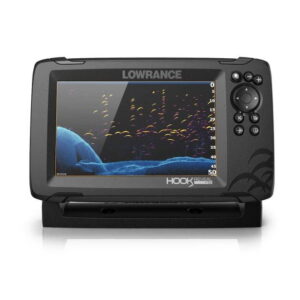 |
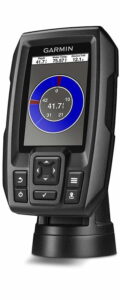 |
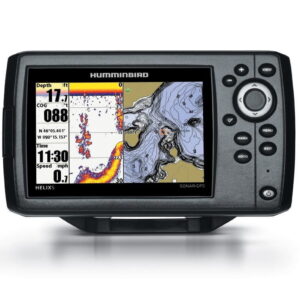 |
 |
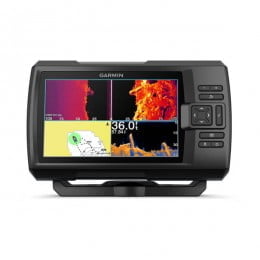 |
| Frequency: CHIRP 200 kHz; DownScan/SideScan 455/800 kHz | Frequency: 2D Sonar: 200 kHz / 15° and 77 kHz / 45° | Frequency: Medium and High CHIRP 75/155 kHz + 130/250 kHz | Frequency: 90 kHz and 290 kHz | Frequency: 50/77/200 kHz, CHIRP 83/200 kHz, ClearVu/SideVu 260/455/800 kHz |
| Screen Size: 7" | Screen Size: 3.5 | Screen Size: 5 inch | Screen Size: N/A | Screen Size: 7” |
| Resolution: 800 x 480 SolarMax | Resolution: 480H x 320V | Resolution: 800x480 | Resolution: N/A | Resolution: 800x480 |
| Imaging: 150 ft. - 300 ft. down; 100 ft. per side (800 kHz)/ 300 ft. per side (455 kHz) | Imaging: N/A | Imaging: 350 ft. Down, 250 ft. Side | Imaging: N/A | Imaging: ClearVu 500 ft, SideVu 500 ft (250 ft per side)* |
| GPS: Internal, High-Precision | GPS: Internal, High-precision | GPS: Internal, High Precision | GPS: N/A | GPS: Internal, high precision |
| Maps Included: None OR 4000 US Lakes OR C-Map Contour+ | Maps Included: Not Available | Maps Included: Humminbird Basemap | Maps Included: N/A | Maps Included: N/A |
| Max Waypoints: 3000 (100 routes/100 tracks) | Max Waypoints: 5,000 | Max Waypoints: 2500 | Max Waypoints: N/A | Max Waypoints: 5,000, 100, 50 (50 000) |
| Memory Card Slots: Micro SD | Memory Card Slots: N/A | Memory Card Slots: Micro SD | Memory Card Slots: N/A | Memory Card Slots: N/A |
| Transducer: DownScan | Transducer: 77/200 kHz CHIRP | Transducer: XNT 9 SI 180 T | Transducer: N/A | Transducer: GT52HW-TM* |
| Transmit Power: N/A | Transmit Power: 200 W (RMS) | Transmit Power: N/A | Transmit Power: N/A | Transmit Power: N/A |
| Screen: N/A | Screen: backlit, HVGA color | Screen: N/A | Screen: N/A | Screen: HD, backlit |
| Best Price (Amazon) Best Price (Bass Pro) Best Price (Amazon) Best Price (Bass Pro) Best Price (Amazon) Best Price (Bass Pro) | Best Price (Amazon) Best Price (Bass Pro) | Best Price (Amazon) Best Price (Bass Pro) | Best Price (Amazon) Best Price (Bass Pro) |
The HELIX 5 is an absolute marvel. It offers clear, crisp down and side imaging, great maximum depth, and tons of useful features. This is a full-on chartplotter/GPS combo with all the features you’d expect. You can download charts, make your own, create waypoints, and more.
We’re absolutely astonished that Humminbird was able to fit so many features in such a small unit. We’re also amazed at how affordable it is. Note that this unit is customizable: You can get it with down imaging, down and side imaging, or no imaging at all, depending on your preferences and price range.
With a 5” screen, the HELIX 5 will fit neatly in most small setups. Love fishing in small boats? This might be the perfect unit for you.
With its 7” screen, the STRIKER 7 is designed for small to medium-sized boats - you won’t be able to fit it in a kayak, but it will work for many small setups.
We love this unit - the price is right, the down and side imaging are both crystal clear, and it offers great sonar and excellent target separation. This is a GPS fish finder, but you can’t add any maps - you have to chart your own. For many anglers, that’s a fair compromise considering the relatively low cost of the STRIKER 7.
The unit has a well-laid-out user interface. It’s easy to set up, it’s jam-packed with features, and it connects to Garmin’s ActiveCaptain app, one of the best apps in the fish-finding game. For boats of the right size, the STRIKER 7 is a winner.
No matter how small your boat is, you’ll be able to find fish using the Deeper Smart Sonar CHIRP fish finder. This is a castable fish finder, which means you don’t have to mount your transducer. Instead, you cast the unit into the water, then connect it to your phone via Wi-Fi.
While the Deeper Smart Sonar CHIRP fish finder doesn’t have imaging, it does feature CHIRP sonar - a rarity among castable fish finders. The unit also comes with a GPS, so you can create your own contour maps, and you can purchase a subscription to access charts created by Deeper.
This is our favorite castable fish finder - it’s perfect for kayaks and other very small fishing vessels.
The STRIKER 4 will fit perfectly in most setups - you can even fit it on a kayak without drilling (or any other tools). This is an inexpensive, easy-to-use fish finder that offers down imaging at an incredible price - you can also get a model without imaging if that’s your preference.
The power of the transducer is mindblowing considering the size of the unit; we don’t know of any other fish finder with a 4” screen that offers 800 kHz CHIRP-powered imaging. And you get all the features you might expect of a great Garmin unit: An excellent user interface, great target separation, a ton of different colorways, and more.
You can’t purchase charts for the unit, and it doesn’t come with any base maps, but you can use QuickDraw contours to make your own charts. The STRIKER 4 is also ActiveCaptain compatible - this is a wonderful little unit.
The HOOK Reveal 7 is a top of the line fish finder, suitable for small to medium-sized boats. You won’t be able to fit the unit in every small vessel, but for the boats that have the space, it’s a winner.
What can you look forward to with the HOOK Reveal 7? Excellent mapping features, including options to get great map packs like C-MAP Contour+ out of the box. Great imaging, including both down and side imaging at a maximum of 800 kHz.
Variety is the spice of life, and you can purchase the HOOK Reveal 7 with a wide variety of different transducers and imaging capabilities to fit your needs. All of them feature CHIRP sonar - this unit offers great target separation and a whole host of excellent features. Looking for something a bit smaller? The HOOK Reveal 5 is an excellent fish finder - though it doesn’t have side imaging capabilities.
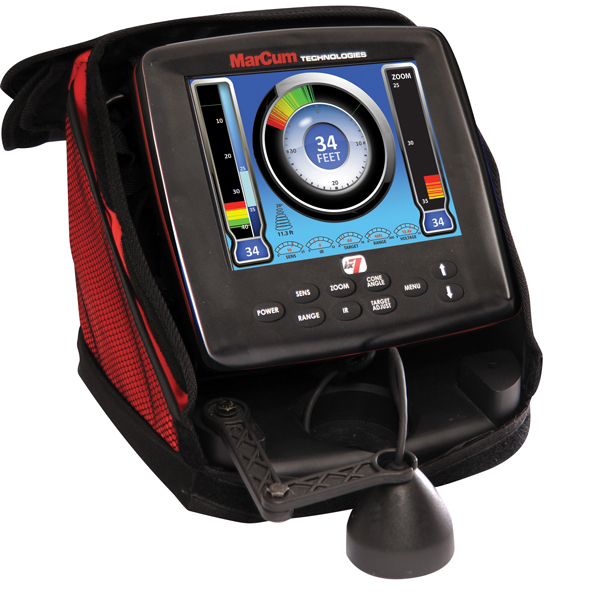
Small vessels present unique challenges that can make it difficult to choose the right fish finder. All of the fish finders we covered above are great choices for small boats. We analyzed fish finders based on a number of different factors, then chose our favorites.
What are the factors we considered? The size and quality of the display, the frequency the fish finder is compatible with, the transducer that was included, ease of mounting, size, portability, and durability.
Want to make your own comparisons to find the perfect fish finder for your boat? Read on to learn why the factors we considered are so important, consider your own fishing preferences, and choose the fish finder that’s right for you.
When choosing a fish finder for a kayak or another small vessel, size matters. There’s no way you’re going to be able to mount a unit with a 10” screen.
Fortunately, just because you’re sacrificing screen size doesn’t mean you have to sacrifice display quality. Each of the units we recommended above has exceptional display quality - though when it comes to the castable/wireless models, the quality of the display depends, of course, on the quality of your phone.
If you’ve read some of our other reviews, you’ll know that we love hybrid touchscreen/keypad models. Touchscreens are, however, far less important on small boats. The reason for this is simple: The smaller screen sizes make touch screens almost unusable. Keypad controls are almost always for the best when you have a small screen.
Higher frequencies mean clearer images, but there’s a cost - the range of your sonar will be reduced. That means high-frequency sonar is better in shallow water, while low frequencies are better in deep water.
Imaging sonar is universally high frequency - most imaging starts at a minimum of 455 kHz. That means if you want the improved view of side and bottom structure that imaging provides, you’re going to need a fish finder that can handle higher frequencies.
Many anglers have a preference for the depth of water they’ll be fishing in. If you know you’re mostly a shallow water angler, you’ll want a fish finder that supports high frequencies. Conversely, if you mostly fish in deep water, a fish finder that supports frequencies of 200 kHz and less is best.
The fish finders we recommend above support a wide range of different frequencies - there’s a fish finder for every preference. And for those of you who switch between shallow and deep water fishing, opt for a fish finder that offers the widest range of frequencies possible - you’ll find some fish finders that fit the bill above.
Your transducer is the part of the fish finder that emits sound waves into the water, then receives them. Without a transducer, there’s no sonar, and with no sonar, your fish finder is little more than a glorified GPS (if that).
Aside from the frequencies at which your transducer can transmit and receive sound waves, you’ll also want to consider how it can be mounted. Most transducers are transom mounted, which means you’ll mount them at the back of the boat (near the trolling motor). You’ll also find transducers that are castable (they go on your line), and internal transducers (which can be mounted inside your boat).
Generally, you’ll want to opt for a transom-mounted transducer for small motorized boats and for castable transducers for very small vessels like kayaks.
We’ve already touched on imaging, but it’s important to note that in order to get imaging, both your transducer and your fish finder need to have imaging capabilities. Different manufacturers call their imaging by different names. Consider whether you want down imaging or both down and side imaging on your vessel, then find a fish finder/transducer combo that provides the style of imaging you want.
Here’s another topic we touched on briefly - mounting your transducer. For very small vessels, we recommend portable fish finders - you don’t need to mount these transducers onto your boat at all.
Transom mounting a transducer can be a bit tricky if you’ve never done it before - especially on a small boat. Fortunately, Boating Magazine created a comprehensive guide to installing transom-mount transducers. We highly recommend reading it.
There’s a particular problem with small boats - you can only drill so many holes for new transducers! We highly recommend getting a transducer mounting board to avoid this problem - something like this transducer mounting board by Rytek is a good place to start.
Size is obviously the key concern when choosing a fish finder for a small boat, which is why all of the options we recommend are sized to fit smaller boats - some are even suitable for kayaks.
When you’re considering portability, it’s important to keep your whole setup in mind - not just your fish finder/transducer combo. In particular, you should consider how you’re going to power your fish finder.
You can attach your fish finder to the same battery used by your trolling motor in most circumstances (check the voltage to be sure). There’s a drawback to this strategy - your trolling motor can cause electromagnetic interference and make your fish finder difficult to read.
For this reason, many anglers opt to use a separate battery pack for their fish finder. Doing so can also help you preserve battery life and increase the length of your fishing trip.
Of course, you may not have room for a spare battery pack - and on many small boats, you may not have a trolling motor at all. In these circumstances, consider using a fish finder that runs on smaller internal batteries (like AAs).
Fish finders are water-resistant - but most aren’t completely waterproof. In other words, you shouldn’t dunk your fish finder in the lake! That much is probably obvious, but if you’re in a kayak, you should consider getting a waterproof case for your fish finder.
As for durability, fish finders are made out of pretty tough plastic. All the fish finders we recommended above are durable enough to withstand your average fishing trip - just don’t toss them around intentionally to see how much of a beating they can take.
They’re not strictly necessary - though they can be useful if you don’t have other methods of navigation. The advantages of GPS are many - chartplotting can be extremely useful, and you can get it on relatively affordable fish finders.We love GPS and chartplotting functionality - but if you don’t want it, plenty of the options we listed above are simple fish finders without navigation.